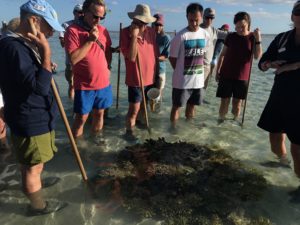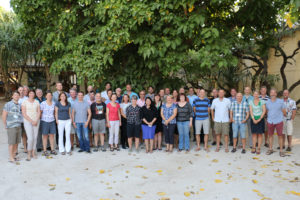Exploring synthetic biology solutions to environmental change
Attendees inspect coral species around Heron Island. Image: Revive & Restore
The Engineering Resilience: Synthetic Biology Solutions to Environmental Change symposium brought together researchers from around the globe to discuss some of the major conservation problems caused by environmental change and to identify possible synthetic biology solutions. The symposium was held 12-14 September on Heron Island, at the southern tip of the Great Barrier Reef, with the resilience of the Reef being one of the areas of focus.
There were four working groups at the symposium: (1) Climate Resilience; (2) Invasive Species; (3) Disease Resistance; and (4) Stakeholder Engagement. Each group was tasked with developing a pitch for a research programme, which was to be presented to a panel representing potential funding sources (industry, government, and philanthropy) on the final (third) day. The pitches were developed over 2 days, composed of alternating working group (break-out) and plenary (reporting/feedback) sessions.
The unique structure of the program led to some truly innovative ideas being presented to tackle environmental challenges. The Climate Resilience group developed a pitch for a programme that would research next generation corals that would be better equipped to deal with the impacts of climate change. The Invasive Species group pitched for a programme that would seek to future-proof biodiversity by engaging Indigenous communities in Australia to co-develop strategies for managing invasive species, with the aim of strengthening and restoring important cultural values. The Disease Resistance group focussed on a problem being faced in Hawaii and made a pitch for a research programme to identify a solution to a new fungal disease currently threatening ʻōhiʻa (Metrosideros polymorpha), the most abundant native tree in the state. The Stakeholder Engagement group proposed to develop a new boundary-spanning international organisation, which would act as a ‘go-to’ group for addressing research questions and implementing programmes for engaging communities in conservation activities involving genomic solutions.
The symposium has led to the development of new collaborations, with members in each of the groups now progressing with some aspect of the proposals they were developing over the three days.
Attendees at the Engineering Resilience symposium on Heron Island.
The symposium was sponsored by CSIRO’s Health & Biosecurity Business Unit and Synthetic Biology Future Science Platform and was co-organised by CSIRO and Revive & Restore, a US-based NGO that promotes biotechnological solutions to conservation problems. The event was modelled on a previous Revive & Restore workshop, New genomic solutions for conservation problems, held in Sausalito, California, in 2015 and built on the collaborations that arose out of that meeting.
The symposium website is available at http://reviverestore.org/resilience/, including the agenda and full participant list.
For more information contact Environment & Biocontrol Domain Leader, Owain Edwards – Owain.Edwards@csiro.au


